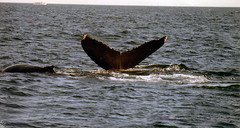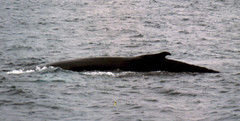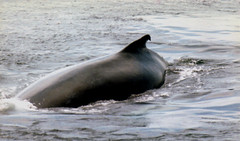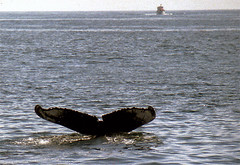First we came on a calf with two adults. One turned out to be FiveJ #0104, known to have a calf that year and the other an accompanying adult. We were curious what the relationship was between FiveJ and this other adult... Was it a male escort (seemed a little early), a sibling of the calf (we couldn't tell since it didn't fluke). FiveJ is on the right diving deeply, the calf is close by her on the left. FiveJ has a very black fluke and there are several other whales with black flukes (probably 200-300!) so the only way to determine this is FiveJ is by carefully following the trailing edge of her fluke which looks like it has been cut with a one of a kind pair of pinking shears.... each whale has a distinct trailing edge but it is not so important on a whale with a distinctly marked tail.

We didn't even have to move the boat, we just drifted with the tide to the next whale which was Fringe #0159, another mother with her calf. As we were arrived the calf breached once, but it was so unexpected that no one caught it on film. Sometimes it is a blessing when that happens, allowing the experience to enter directly into your eyes and heart without glass and technology filtering it. We moved slowly along with Fringe and her calf even though there were several 3-4 Minkes, at least 2 Finbacks and as many Humpbacks all around us.
Fringe was huge! Females tend to be larger than males and she was impressive the largest Humpback I had ever seen. Fringe had been seen since 1979 and had a calf in 1979,1982,1984 and this 1986 calf (the first three were determined to be male). Since she was seen so often up and down the Gulf of Maine, a profile of her character developed: she didn't interact with boats much, she tended to be a loner during years without a calf. She also had a unique way of filter feeding with the tip of her nose just sticking out as she plowed along near the surface. Her 1979 son imitated her technique.

Her dorsal fin was very distinctive and like Talon and, to a lesser degree, Tusk it was possible to identify her before she dove and showed her fluke. This was, most likely, one of the reasons she was so well known.

At one point she turned directly towards the boat... it did not have the warm fuzzy feeling of our encounters with Fissure or Talon. It felt more like she was saying "O.K. that's enough". The captain and I had been surprised by how small her calf was and he was being extra careful to start with. Maybe it was a late calf, born in March just before the whales migrated north rather than a normal January or February birth, or maybe it looked small in comparison to its huge mother. But that was all he needed to know he should let her be. If you go on a whale watch pay attention to how the captain works around the whales.... how much respect he or she gives them.

We saw the blow of another whale that was in the direction of home and it was getting pretty late so we headed 3/4 of a mile to the west and there was Tusk, by himself but close enough to the clump of females and their calves that we suspected they were all well aware of each other. Humpbacks sing when they are on the breeding grounds, long elaborate songs that change each year and are thought to be sung only by males. If they are capable of such complex sounds for breeding purposes, something like bird songs, then perhaps they also have short chirping calls like birds that keep groups together. I would look out over the huge expanse of water and see a far off boat. At first I felt completely detached and distant from them, but soon realized that the captain was in contact with them all the time, comparing weather impressions, helping each other find fish or... whales, keeping tabs on each other, gossiping, arguing and wondered if the whales weren't doing something similar.
We stayed with Tusk for a while but he was busy feeding and did not approach us so we figured it was time to head home. As you can see from this picture, when we were done we called over the other whale watch boat and went on our way. We may have been competitors but had a strict code of not crowding a whale with too many boats and would often take turns riding along with a whale.
